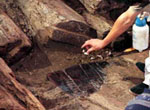Chinese Archaeologists Excavate Beijing Imperial Tomb

Lacquerware discovered in ancient tomb
|
Chinese archaeologists began excavating Sunday the key part of a 2,000-year-old imperial tomb after over six months'careful preparations.
The excavation was telecast live nationwide for the first time with the aim to enhance the awareness of the public to better protect the country's cultural heritage.
Located in Laoshan area in western part of the Chinese capital, the tomb of Western Han Dynasty (206 B.C. to 24 A.D) is only some 10 kilometers from the city center where the Palace Museum stands. It is the second mausoleum of Han dynasty ever discovered in Beijing.
It was regarded as the third most important archaeological discovery in Beijing over the past 50 years.
In the front chamber of the tomb, archaeologists cautiously brushed off the clay on the lacquerware and pottery. Lacquerware is rarely seen in tombs of Han dynasty in north China. What makes these pieces more precious is that they are inlaid with gold plates of different designs, including that of clouds and flying tigers.
A senior archaeologist was invited to the site to explain to audience what the unearthed objects were and what they were used for.
Beijing-based foreign correspondents also went to the site surrounded by apartment buildings, hotels and a large amusement park.
The site was heavily guarded when archaeologists were digging in front of cameras.
The ancient tomb came to the limelight when the police seized several ghouls attempted to crawl into the tomb.
Prior to the ongoing excavation, Beijing has unearthed paleolithic ruins at a construction site in the downtown commercial area of Wangfujing and a 300-year-old tomb in the U.S. Embassy in Beijing.
The growth of urbanization has endangered a spade of historical relics across the country. Deputies to the National People's Congress, China's top lawmaking body, have sternly criticized the wrongdoings that have damaged cultural heritage in three Chinese cities, Anyang, Dinghai and Zunyi.
Rampant smuggling and illegal auctions of cultural relics also became the target of public accusation.
Wang Wuyu, site director with the Beijing Research Institute of Cultural Heritage, said that the excavation of Laoshan ancient tomb is the most deliberate and scientific one he has ever engaged in. Local government, commercial establishments, and the public have been supporting the protection of the mausoleum.
Some archaeologists estimated that the occupant of the tomb was a king of a principality with eminent position. The tomb is of great importance for studying ancient culture.
Han dynasty which lasted for over 400 years is the second dynasty after Qin (221 B.C. to 207 B.C.) that reunified China. It made China for the first time the most powerful empire in the world.
Beijing belonged to part of the northeast frontier of Western Han Dynasty in history. It served as a strategic place to keep out marauding nomads and a place where different nationalities lived.
Heritage of Han dynasty has long been an academic focus for Chinese archaeologists. The gate to tracing back lost Chinese culture was opened when Confucian classics copied on silk and bamboo or wooden scraps were unearthed from a series of tombs dating back to that period in southern China.
"This is an exciting excavation," said Beijing vice-mayor Liu Jinmin, adding that "it reflects the importance a future-prone nation has attached to its own history."
The outer casket and the coffin could be seen when the excavation ended this morning. The coffin would be opened in mid-September, Wang Wuyu estimated.
|